Catalina (September 22, 2016)

The Oceans Seven is essentially the Seven Summits of swimming. After finishing my seventh one on July 13th, 2024, I became the 30th person in the world to have completed this challenge. There’s no official award ceremony or anything, but I do get to brag about being listed in a table on the Wikipedia for having done it.
I’m not the youngest, oldest, fastest or even slowest one on the list, which is honestly fine with me! I’m really proud of the work I’ve done, and I know that at least a little bit of being able to finish all of it was luck.
Compared to other people who have swam the list, I think the most exciting part was my swim-ending shark encounter in the Kaiwi Channel, so I had to reattempt that one. But I’m definitely not the only person to run into a shark when channel swimming, and not the only person to have to repeat a swim on the way to finishing the list.
It’s been one year since I completed the Oceans Seven. Right after I finished, I wanted to write a big tie-it-all-together post, but it got away from me. This first anniversary of the last swim has been a good opportunity for reflection, so here that post finally is.
The bottom line is, each of these swims was a lot of work, and I’m proud I got them all done. I also think I did a good job at stopping to smell the roses along the way, I got to travel to less-visited cities like Tarifa in Spain, Donaghadee in Northern Ireland and Cape Tappi in Japan. Because of the nature of waiting for a the right conditions in a swim window, you get a lot of downtime to wander and explore and immerse yourself a bit more.
Why did I start on the journey? Why did I continue? It wasn’t really a decision that I made at a single point in time. When I started, I just wanted to try a few cool channel swims I cared about, I didn’t think I would even try to finish the whole list, that felt too ambitious. I wanted to start with:
I think after completing The English Channel, my third one, in 2018, I got curious and booked my fourth, the North Channel. Once I completed that (the so-called “hardest” of the seven), I think I had started to come around to the idea of doing them all.
From my first promise until now is about 10 years, and a lot happened in that time. I don’t know that any one single blog post could cover the entire journey, and this one is already both longer than I’d like, yet still missing a ton. Some of my mentors wrote novels about their journeys, but I don’t know if that’s the outlet for me.
Suffice to say, I know I’ve changed a lot over the course of swimming the Oceans Seven. Looking back at the photos of me from when I first started until the finish, I definitely aged! I had more hair when I started, more light in my eyes. I also switched jobs, and moved across the country and back. I’m much more confident in my swimming abilities, but I still usually don’t lead with my accomplishments when introducing myself to new people.
(Ok fine, I do brag a little bit! This year at my new job, when introducing myself at our all-hands, for my “fun fact” about myself, I mentioned that “you can find me in the Wikipedia for my open water swimming accomplishments”)
The Oceans Seven was definitely always in the back of my mind for a lot of the last decade, but I do think I was able to maintain a balance and live my life. Sure, during peak training seasons, I had to say no to a lot of social plans, but swim training also is a social plan. A lot of my closest friends are open water swimmers, and it’s really special to have people around you who are just as nuts as you are.
I can definitely say that the moment I touched the rocks at the end of my last swim, I felt so much relief. I had started to create a lot of internal pressure in my mind to finish the list. Like I said, nobody ever makes you do it, but there ends up being a lot of “expecting people to expect you to finish” kind of pressure.
A few weeks after I completed the Oceans Seven, The South End Rowing Club hosted a celebration for me (it’s tradition! I’m the fourth member of the club to complete it) I gave a speech that was recorded and posted on WOWSA that covered a lot of this same section.
I categorize myself as a marathon swimmer, or more precisely, I do “solo unassisted” swims. It sounds very “lone wolf”-esque but marathon swimmers know: every “solo unassisted” swim is neither solo, nor truly unassisted. You’ve got crew members on your escort boat handing you feeds, pilots and deck hands guiding you, sometimes kayakers, during these hourslong swims (often on boats with no bathroom). That doesn’t even begin to cover all the people who help you with training, planning, advice, and everything else. I have so many people who have assisted me on this journey.
My parents, Joanne and Steve have been so supportive of me every step of the way. They started me with swim lessons at a pretty young age, and in elementary school, they had me join an age group swim team, and they paid for private lessons outside of the swim team. Even though I rage quit swimming by about 5th grade or so, logging those hours in the water so young was a huge leg up for the rest of my swimming career. By the time I got back into swimming in high school, I got to be a varsity swimmer starting my freshman year. I didn’t set any records or anything, but it gave me a lot of confidence in my ability to swim.
Vanessa Slavich: Every so often, you meet somebody who changes your life. For many people, and especially me, Vanessa was that somebody. We worked together at Square, her 140-character intro bio was something along the lines of “I will probably convince you to do a triathlon” and lo and behold a year or two later, I got convinced to do a half Ironman. Vanessa knew I loved swimming and through some connections, Vanessa introduced me to Kim Chambers, who had already swam the Oceans Seven, and directly inspired my journey. Vanessa was such incredible support throughout my journey, she crewed my Gibraltar swim. She had a desmoid tumor that eventually took her life in 2022, before I finished the last three. Among the many reasons I wish she was still here, I want to be able to thank her so much for really sparking my Oceans Seven journey.
Kim Chambers: The day we met, Kim Chambers made me promise to swim the English Channel. The rest, as they say, is history. I had an inkling of maybe attempting it, but having an external person who I had made a promise to, made that so much more real. I wasn’t a part of any open water swimming clubs, and Kim encouraged me to check out both the Dolphin Club and the South End (she is a dual member). She helped me do some of my longest training swims while preparing for Catalina, and her support and mentorship has been incredible. I can honestly say I don’t think I’d be on this side of the Oceans Seven without her.
Brian Ip and I worked together at Square and joined the South End Rowing Club on the same day. We tried out both the Dolphin Club and The South End together, and agreed which one was a better home for us. The South End is such a big part of my life right now, and it was really scary to think about joining alone, I’m so glad that Brian was there with me. We co-created a “pod” (a group of swimmers), the Breakfast Pod, which has been a great way to form our own community and welcome additional people into open water swimming.
Mandy Hoskinson: Mandy has been my most consistent crew for this challenge. Starting with the English Channel, through the North Channel, my first Kaiwi attempt, and finally finishing with Tsugaru, Mandy has been there through some really tough times. She’s such a solid, reliable person who has a great read on me and even predicts what I need before I know it. In terms of just time alone, Mandy’s probably logged over 50 hours of swim crewing for me. Mandy is an incredible photographer and many of my favorit photos from these swims come from her, including the ones in this post.
Mandy wrote up her perspective of what it’s like to be swim crew for me and it’s one of the sweetest things anybody has ever written about me, her affection pours through that post.
Simon Dominguez: Simon has been an incredible mentor and supporter. I tend to keep my mouth shut about what I’m doing, and Simon’s advice has always been “tell people what you’re up to!” And he’s right, the number of random connections I’ve made just by letting folks know what I’m training for has been incredible. And Simon facilitated the chance connection that I needed in order to be able to schedule that last swim.
Separately, there was a moment somewhere along the way (I think after I had finished six of the seven) where I was catching up with Simon and expressing feelings along the lines of “maybe it’s not worth the hassle to try to arrange the last swim.” Simon looked me right in the eye and said, “Zach, you need to finish the Oceans Seven. The South End needs to throw you a party. I can taste your party” and that sat with me. It did add a lot of pressure, but in the end it was really special to complete, to throw that party and share that moment with and entire club of people who helped me too.
Amy Gubser: Amy is an incredible swimmer who in 2024 became the first person to swim from SF to the Farallons. Back in 2015 when I first joined the South End, she quickly became somebody I’d train with and get advice from. I found out she was swimming Catalina and immediately I booked that same boat for the next day after hers. Originally she was offering to crew for me (which is bold to not give yourself any recovery), but she got sick after her swim so she couldn’t. Amy did crew for my Santa Monica swim, and she’s generally been great support throughout my open water swimming career.
Antonio Arguelles: I got connected to Antonio through Kim a long time ago when I did a training swim with Kim. About a year or so later, he became the 7th person to finish the Oceans Seven and he has been yet another incredible resource and mentor. Antonio gave me great advice for the North Channel and for Tsugaru as well.
Miguel Melendez has kayaked for so many of my training swims and been a great source of support and jokes when I’ve needed them.
Steve Walker: Steve is another South End Member who has completed 6 of the Oceans Seven(and attempted them all), and gave me lots of useful advice for each swim. He connected me with Philip Rush for the Cook Strait (Philip is notoriously hard to get in touch with) which was so valuable.
Evan Morrison: I got some great swim technique lessons from Evan before my Catalina swim, and also have used his track.rs Tracker Site to share my route for all my channel swims. His Long Swims DB has become like a de-facto reference for swims and I loved tracking my progress on its Oceans Seven page.
Joe Butler: When I joined the South End, Joe Butler was assigned to me as my “guide dog” or buddy for new members (somehow Brian didn’t get one). He showed me how to join the correct mailing lists, to swim our sunrisers swims, and he even piloted my English Channel qualifying swim.
Sylvia and Bryan from Pacific Swim Co have been a great piloting service here in San Francisco, and they’ve piloted some key swims like my North Channel qualifier and other 8-hour swims that have been great final checkpoints before channel attempts.
The Breakfast Pod: The pod that Brian and I formed starting in 2015 has become a solid fixture at the club, and a very important part of my life! Wednesdays and Fridays every week! I like to say we’re open to everybody but others first described us as the “young fast pod” and after recruiting some more. More recently I’ve heard us described as the “young gay fast pod” even though we’re not that young anymore, and at least half the pod is straight.
The Girlinas: My weekend pod, we formed in 2021, known for our “leg day” group photos practicing sticking our legs out of the water, and a huge amount of support during heavy training seasons.
SF Tsunami: The LGBTQ+ masters swim team here in San Francisco that I joined in 2013. Being part a community of queer swimmers like me has been really rewarding, and the team has its own incredible history. On top of that, I think pool swimming has been a great complement to open water swimming, Coaches like Casey Cheung and Dave Froelich can write a tough set when they want to!
I wrote about each swim right after I swam it, and got better about collecting more details and stories over time. Here are links to those posts, and some extra info for each swim:
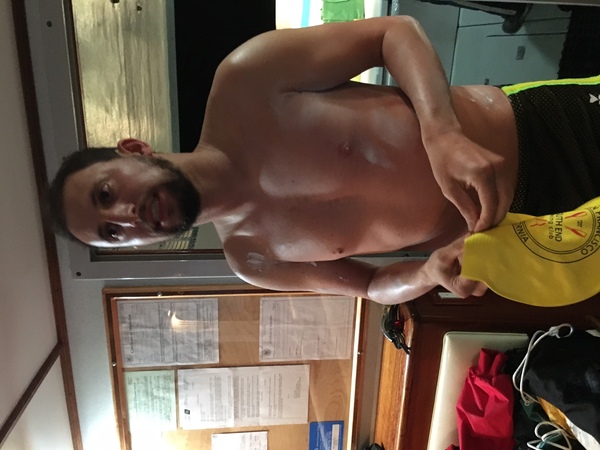
Getting ready to swim from Catalina, around 11pm. Photo credit: Mom
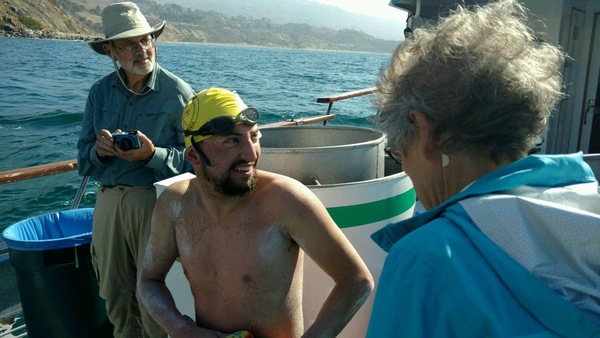
Back on the boat with my parents after completing Catalina. Photo credit: Kelley Prebil
I had a great time on this swim! It was such a big milestone for me.
My swim had atypically rough conditions for Catalina, with really large swells and every single person on the boat got super seasick. I am forever grateful that they still let me swim and finish. I was fine, the swells were slow enough that I could easily swim over them, and in the dark, I had no idea how big they were. I had truly no idea how rough it was for the crew until I got back on the boat and everybody was pale-faced. One observer, Julie had only puked one other time observing Catalina channel swims in like a decade of doing this.
Special thanks to:
Kelley Prebil is a member of the South End and she’s also an observer for the Catalina Channel Association. She observed Amy’s Catalina the day before mine and got right back on the boat with maybe a 3 hour nap in between. Kelley is a trooper and I really appreciate her support!
Mom and dad both came on this swim and both got super seasick.
Robin Hipolito and Ryan Rockenbach were my two kayakers, who were solid support.
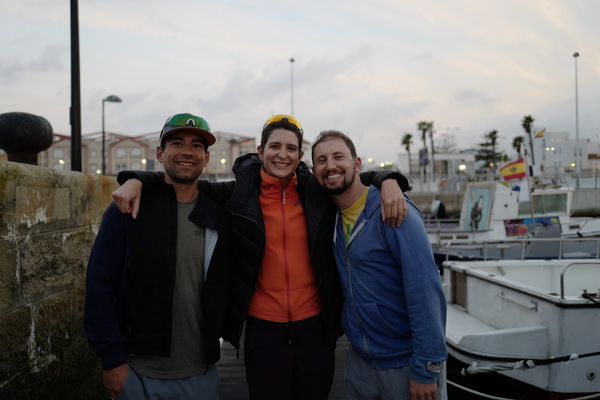
With Chris Esparza and Vanessa Slavich at the docks before the swim
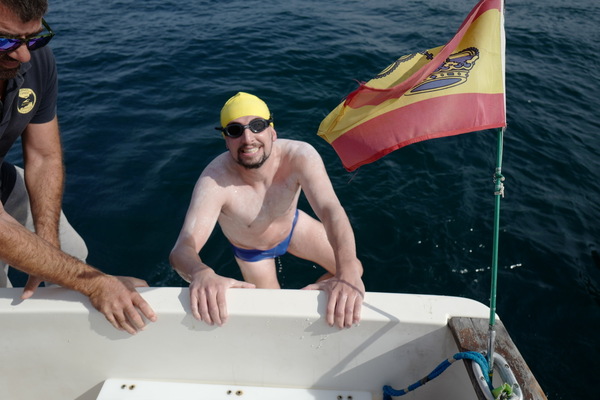
Getting back on the boat after touching Morocco. Photo credit: Vanessa Slavich
This swim was such a delight. I loved staying in Tarifa. I would definitely repeat this one if I had a chance (it was only four hours!). The rest of the trip was so fun, I posted as much as I could about it in my Spain travel blog
Special thanks to:
Vanessa Slavich and Chris Esparza crewed for this swim, and I’m so grateful for their flexibility, since this turned out to be a tandem swim with Atila Manyoki from Hungary.
Jack Danger Canty flew all the way out to Spain to crew but because I swam so late in my window, he couldn’t be on the boat, but I still really appreciate the trip and the time we got to spend in Tarifa!
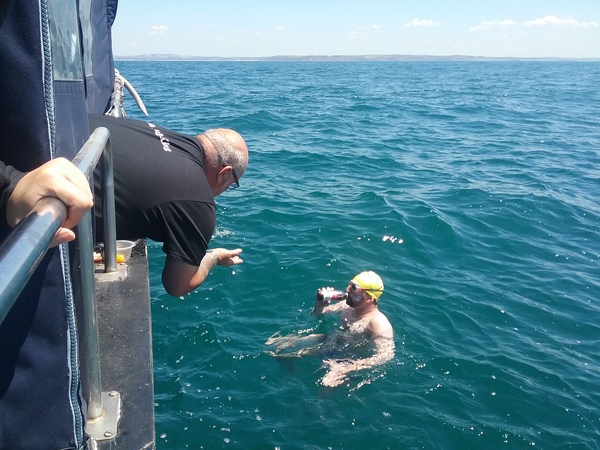
Pilot Andy King giving me an update during a feed
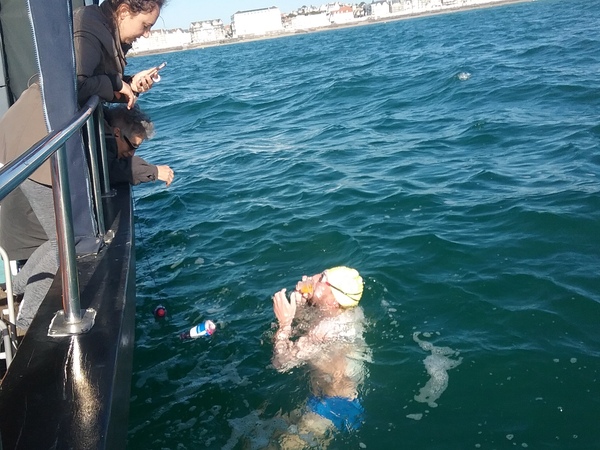
Mandy and my mom hyping me up at my last feed before going in to France
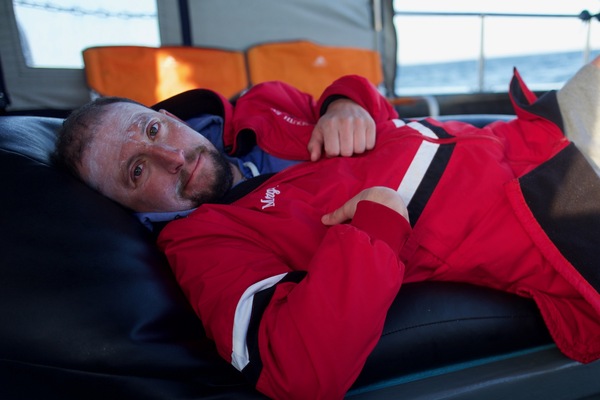
After completing the English Channel. Photo credit: Mandy Hoskinson
Honestly, the English Channel was probably the low point of this list. I thought it was just conditions in the channel that day (even the other swimmers and relays that day get swept much farther south than normal) but with the benefit of hindsight, I think it was the bad sleep that I got two nights before. My friend Jing’s husband Chris explained that he thinks that for a big athletic event like a swim, it’s not the sleep the night directly before that matters, but two nights before.
Three days before the day that ended up being my swim day, the forecast was not looking good, so we took the chance to go see Stonehenge for the summer solstice. Going to the solstice was a night of staying up very late to see the sun set, and then waking up at like 4am the next day for the sunrise.
On the drive back from Stonehenge is when I got the call from my pilot that the swim was on for the next day, so even though I got decent sleep that night, there was no chance to make up for the lost sleep.
Seeing Stonehenge (specifically for the solstice) was a bucket list item for me, and I have some of my favorite photos I’ve ever taken in my England travel blog from it. I don’t regret going to see it, but I do wish I’d given myself a little more grace for how that swim turned out.
Since it’s so well-known, I got the biggest response and the most celebration from people for finishing it.
Special thanks to:
Mandy Hoskinson crewed for me for the first time, and she picked things up so quickly
Mom crewed as well, and I am so appreciative of her being there. A typical feeding pattern for an open water swim is that you quickly toss a bottle on a rope at the swimmer, so they can grab it and drink from it. For one feed, mom slowly lowered the bottle down to me, and I snapped a little bit at her (bad! I know!). Luckily things got better the rest of the swim.
Andy King was my pilot for this swim and he was crucial because he gave me my “come to Jesus” moment where he threatened to pull me if I didn’t get my act together and swim more consistently. His exact words were that I needed to “pull my finger out of my ass and focus.” He later admitted he wouldn’t have pulled me, but it was absolutely the mind game I needed that day.

A few hours into the North Channel during the sunrise. Photo credit: Mandy Hoskinson
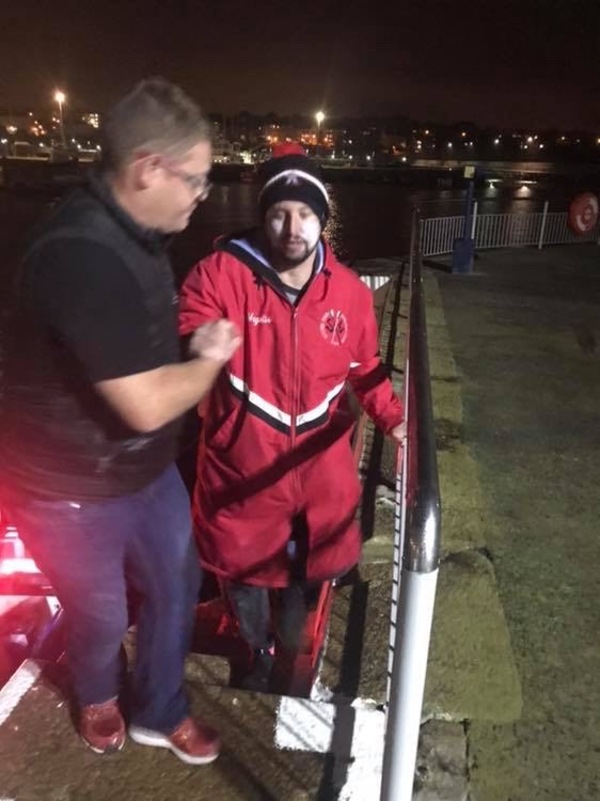
The blurry messy photo back of Padraig Mallon walking me back up the docks that Infinity posted to their Facebook.
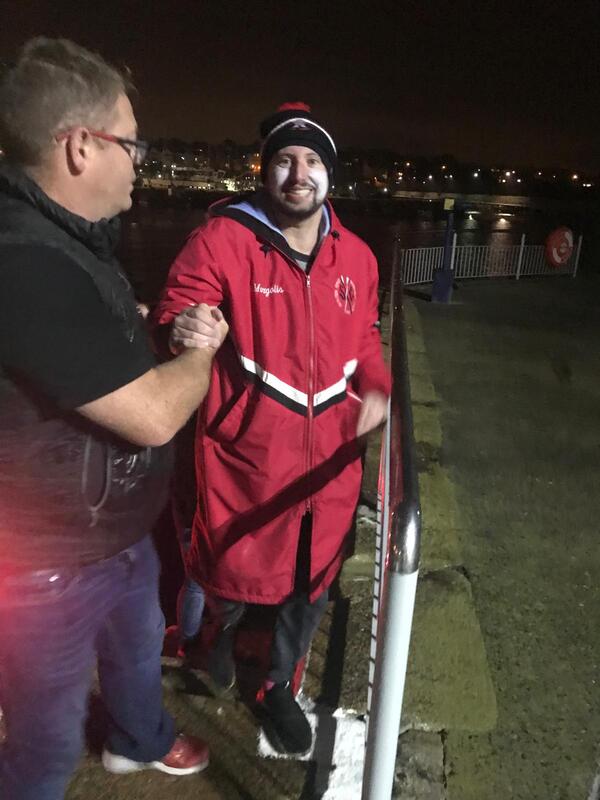
A photo taken moments earlier where I was much more present. Photo credit: Infinity
The North Channel was by far the hardest swim on my body out of this list, and luckily it wasn’t due to jellyfish (this swim is known for its lions mane jellyfish). Luckily the water was very clear and as soon as it got light enough to see, there was always one crew person on the boat looking for jellyfish and directing me to dodge left or right to get around big patches of them. The day after the North Channel, I still felt seasick on land, and somehow on this swim I ended up with acid reflux-like symptoms after, my throat was bugging me for about a week.
Staying in the town of Donaghadee was such a delight. I loved meeting the Chunky Dunkers, who change the time they swim at every day to go with the tide in the harbor.
I loved being able to explore Northern Ireland and see things like the Giants Causeway, and my Northern Ireland travel blog contains as much as I could collect from that trip.
Special thanks to:
This is the one where I ran into a shark.
It’s hard to describe, but I was much less angry or upset after having to scrap this swim than I thought I would have been.
I had a great time visiting Oahu for the first time, and the locals swimmers were super welcoming. We saw dolphins off Tracks Beach on my first swim there!
Special thanks to:
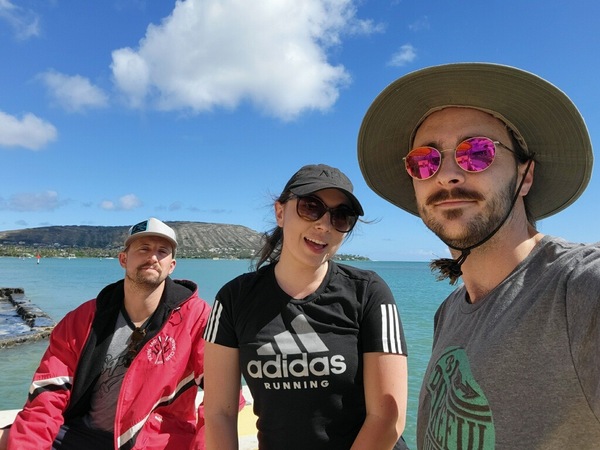
With Mandy Hoskinson and Neal Olson on Oahu before boating over to Molokai
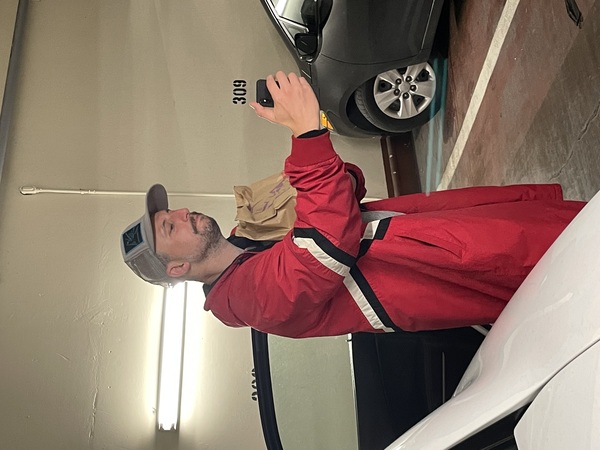
Taking a selfie with my consolation Taco Bell back in our hotel parking lot. Photo credit: Mandy Hoskinson
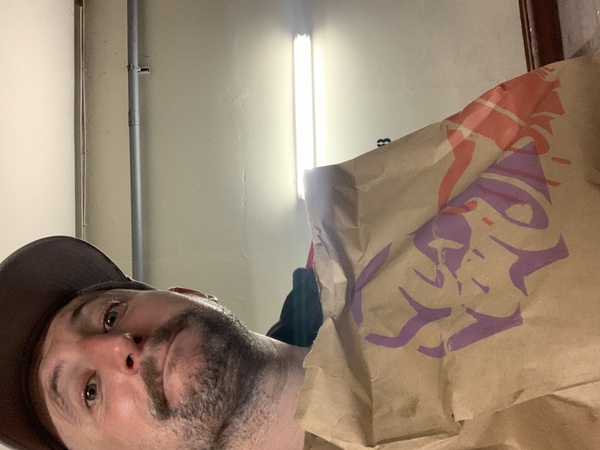
The selfie itself
Back for another round! Fortunately it was successful, this was the longest swim of my life at 15hr47min. For the only time in my Oceans Seven, there were people at the beach I landed on, including a local news crew!
Special thanks to
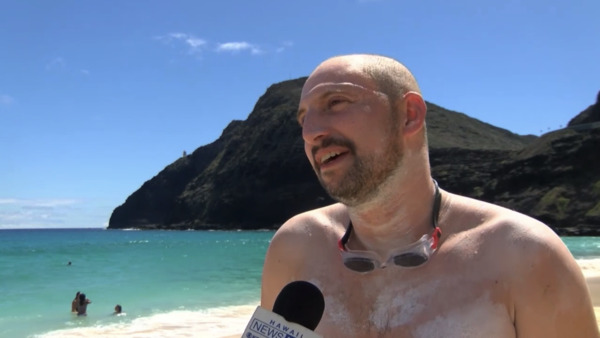
Being interviewed for Hawaii News Now after finishing at Makapuu Beach
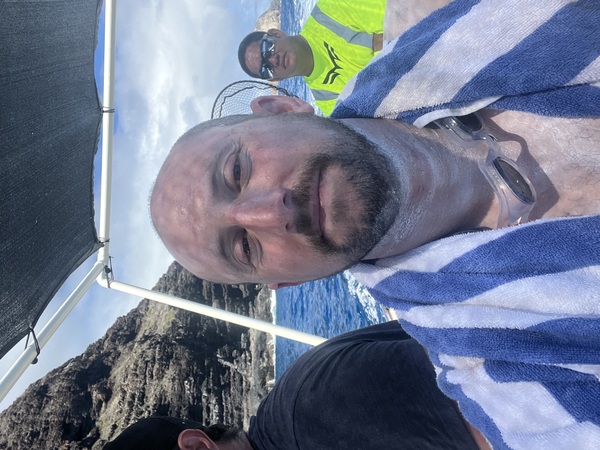
Selfie after swimming back to the boat
This swim was one of my favorites, I got lucky with stellar conditions.
In terms of travel, New Zealand was wonderful. One of the highlights of my trip was being able to meet back up with Kim Chambers and visit her family’s farm. And since I was on that side of the world. I got to go to Australia after and visit the Bondi Icebergs and the Bondi Salties. My New Zealand/Australia has so many good memories.
Special thanks to:
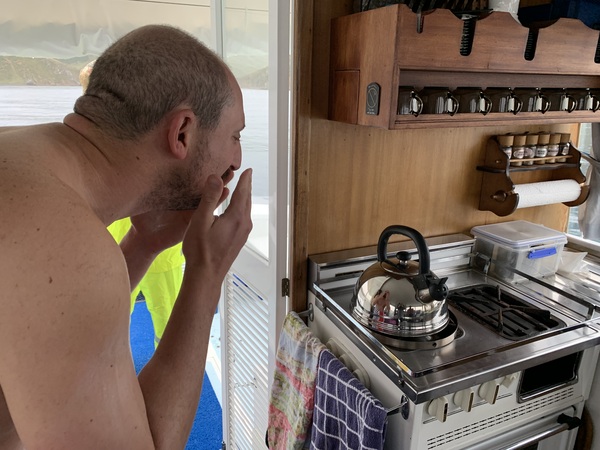
Using a kettle as a mirror to put dessitin on my face before starting the Cook Strait. Photo credit: Amanda Foster
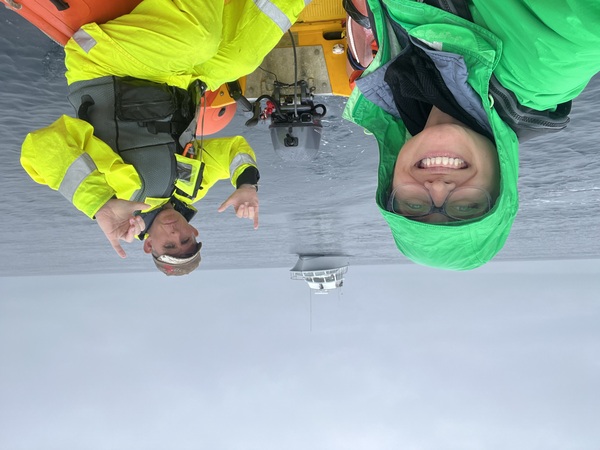
Amanda Foster and Corey Fairbairn in a selfie on their RIB with the bigger escort boat behind them. Photo credit: Amanda Foster
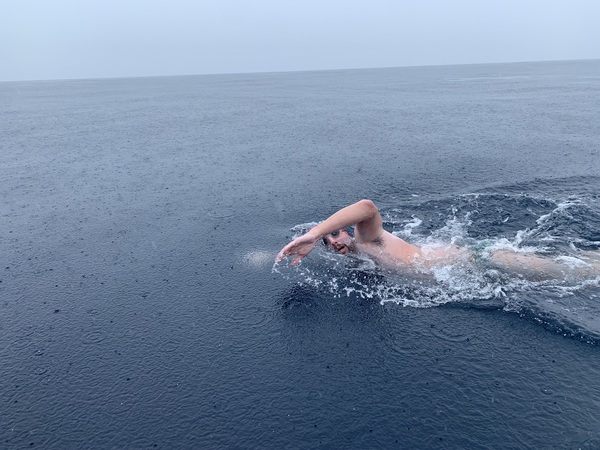
Mid-channel with rain. Photo credit: Amanda Foster

Mid-channel in a clearer patch of weather. Photo credit: Amanda Foster
I loved my trip to Japan, it was a great chance to brush up on my Japanese. I really loved learning about the Seikan Tunnel (the tunnel underneath the Tsugaru Strait) and being able to take the bullet train through the tunnel to Hokkaido a few days after my swim (it was much faster and much lower stress than swimming, let me tell you that).
Special thanks to:
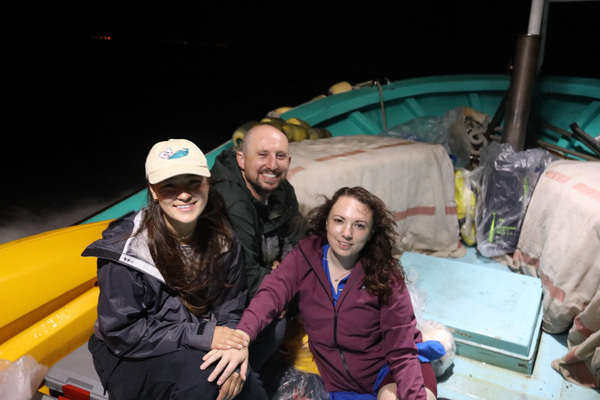
With Lenny Soule-Siler and Mandy Hoskinson on the boat ride out to the start.
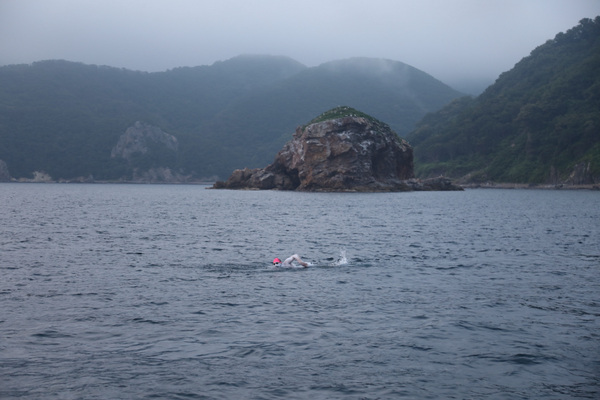
The start of the swim off of Honshuu. Photo credit: Mandy Hoskinson
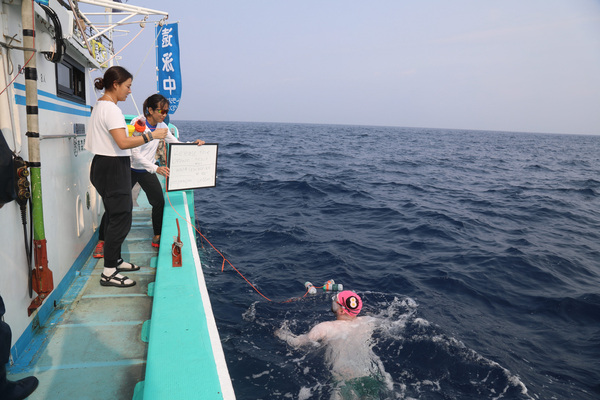
Lenny giving me a feed in the middle of the Tsugaru Channel, with Maya Yatsu holding a whiteboard. Photo credit: Mandy Hoskinson
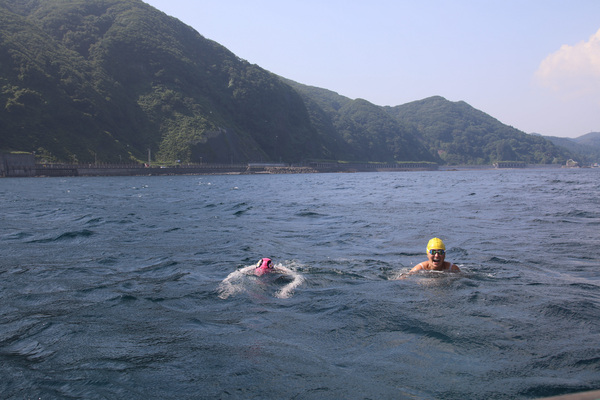
Lenny jumped into the water to congratulate me after I finished. I was wiped. Photo credit: Mandy Hoskinson
I think open water swimming exists somewhere at the intersection of extreme grit and extreme luck. Obviously the faster of a swimmer you are, the better you’ll do, but there’s a lot of luck as well. If an open water swimmer tells you conditions don’t matter, and that they can handle absolutely anything, they are probably lying or ignorant.
Which is all to say, I’m proud of my swimming ability, but I know that some big part has been being lucky enough to have had calm enough conditions to swim, and blessed not to have any career-ending animal encounters or other health issues.
And on top of that, I’m fortunate to be in a position to be able to afford the time to train for these swims, as well as pay for the airfare, lodging and boats that these swims require.
There’s also the angle that, these are crossings that many people attempt as a last resort as refugees to improve their lives. But we do them nearly naked, in the reverse direction, for sport. The English Channel and Gibraltar are just two crossing that people try to make as refugees, with over 20,000 English Channel migrant/refugee crossing per year since 2021.
There’s some sort of dark irony in that contrast, that I don’t know if many open water swimmers wrestle with at all. I don’t feel like it comes up in conversation often. It’s been on my mind a lot recently, since in the US in 2025, we have our own Immigrations and Customs Enforcement terrorizing our own communities. I have some more searching to do, to be able to better support refugees and immigrants, whether they crossed by land or by sea.
The Oceans Seven is a relatively modern concept, it was only invented in 2008. I think the previous “peak” of open water swimming was completing the Triple Crown, which coincidentally has a 2/3 overlap with the Oceans Seven (The English Channel and Catalina).
The nature of any list like the Oceans Seven is that once it’s out there, it becomes a little bit of a rat race, a mad rush to check items off the list, and the accompanying sense of frustration when your ideal plan hits a snag. I say, only half joking, that the actual challenge of the list is booking pilots and slots, not the actual swimming.
I feel like there’s a generation change happening, or a changing of the guard a bit in the Oceans Seven. Change is natural but I worry that there are doors closing behind me that I can’t prop open myself for the next generation.
The group that runs Strait of Gibraltar swim, ACNEG had a passing of the torch. I started emailing with Rafael Gutierrez Mesa in 2015, but when I followed up in 2016, his daughter Laura had taken over, and I found out this was because Rafael had passed away. Laura and team do a great job, they still run the swims, but everybody I know has challenges emailing and contacting that organization.
There are not many options to swim the Tsugaru Strait. After Ocean Navi’s challenges in 2023, they no longer accept international swimmers. Given the nature of the Oceans Seven and the kinds of people who attempt, it’s basically the same as closing down forever to most swimmers. Mr. Ishii came back out of retirement in 2023, and took four of us swimmers in 2024, but then he planned to go back into retirement, with the town of Nakadomari slated to take over in October 2024. When I finished, in July 2024, there was nobody I could forward interested swimmers along to. I know that Maya Yatsu, who was a translator and crew for my Tsugaru swim, is working with WOWSA and is personally invested in keeping Tsugaru a viable option for the Oceans Seven, so I am hopeful that there will eventually be more options.
In some places, things are getting much better! In 2019 on Steve Walker’s recommendation I reached out to Linda Kaiser as a pilot for Kaiwi/Molokai, and found out that she had passed away in 2018, so I had to search around for other pilots. At the time Kaiwi didn’t have a very easily reachable association backing it, so there wasn’t a good resource to find alternatives, I had to ask around. Luckily, there is now the newly-revitalized Ka’iwi Channel Association who can assist. I swam with, and am still in touch with a few of the board members there, and I trust that they will continue to do great work and help more folks along the way.
I really appreciate all the people who have helped connect me with various pilots, and locals, and it’s a bummer to not be able to pay it forward immediately.
The Seven Summits is defined basically “algorithmically,” the goal is to summit the tallest mountain on each continent. There’s a generally accepted list of what the tallest summit per continent is, but in a shocking twist (to me, at least), the definition of a continental boundary is a little looser! So there are varations on which seven summits people use, but there are multiple accepted solutions to complete the challenge.
The Oceans Seven is a fixed list, there are no widely-agreed on substitutes for doing these seven specific swims. You can land at different beaches, you can swim the other direction, but you can’t switch channels.
I would like to live in a world where we can discuss a list like the Oceans Seven where it is defined more algorithmically, as a set of criteria that people can match to.
I think that the world is a big place, why are two of the swims in the United Kingdom of Great Britain & Northern Ireland (English Channel, North Channel), and why are two in the United States (Catalina Channel, Kaiwi/Molokai Channel)? By definition, the Seven Summits are geographically distributed all over the world and not pinned to any one country. Other lists like the Toughest Thirteen have the same problem to me: three of those swims are in the SF Bay area, and a fourth is still on the US west coast.
Similarly, there’s a huge variation in length of the swims! Point to point, the Strait of Gibraltar is half the English Channel, but the English Channel S-curve shape means some of us end up tripling that distance.
The bummer about swimming compared to mountaineering is that we can’t find a single maximum for the distance metric, the way the height of a summit can be. The goal of most swims is to swim the shortest distance between two points, instead of the longest. You could come up with a longer and longer swim, and inevitably somebody would find a way to do it, probably.
Each of the Oceans Seven swims have slightly different rules. For example, why does the Cook Strait permit a 10-minute safety pause where swimmers can get in the boat if there is a shark, but Kaiwi/Molokai does not? I’ve heard that the Cook Strait rule has only been necessary once and the swimmer was able to complete, but have heard of multiple stories (including my own) where a Kaiwi crossing was interrupted by a shark and there was no opportunity to complete the swim.
I think it would be fair to say all swims should offer the same affordance, or none of them. I’m trying not to overcorrect or retroactively saye my Kaiwi DNF should have counted. I have made peace and accepted how it turned out, but I think it highlights inconsistencies between the swims.
So if I were creating the Oceans Seven from scratch today, I would probably say something along the lines of “one swim per continent (or sea) that’s at least 15mi straight-line distance” but there would need to be some exception for Antarctica (or Arctic sea). The concept could use a lot of refinement, but I’d love to see something a little more open-ended. I fully expect that the English Channel, as a classic, well-known open water swim, would frequently end up on the list of swims people choose to complete their Oceans Seven, but maybe it wouldn’t be a hard requirement.
At home, I celebrate my swims with wooden maps. My living room maps are my trophy wall.
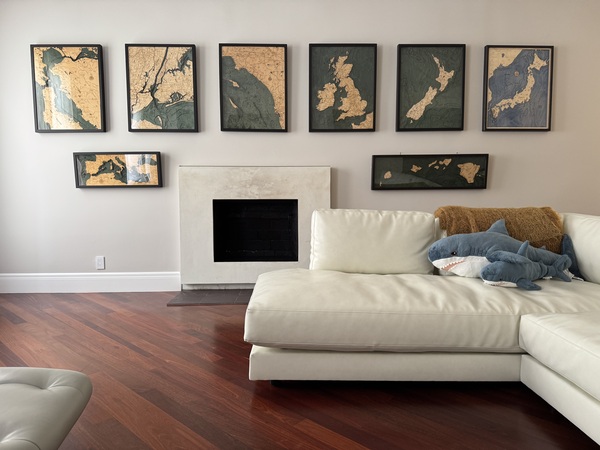
My living room swim wall, featuring big and little IKEA Blåhaj sharks. Yes, I know the maps are not all perfectly flush.
I have a rule that I can’t even order a map for a swim until it’s successfully completed, so it’s been really fun to collect these one-by-one for each swim.
People who know how to count might observe that there are eight maps, so for a post about the Oceans Seven, something doesn’t add up. The wall includes two maps not part of the Oceans Seven, specifically Manhattan (for the 20 Bridges Swim, part of the Triple Crown) and San Francisco, both because it’s home, and also to celebrate my County-to-County swim The English Channel and the North Channel share a map so that center-right one is pulling double duty, which is why with two extras, there aren’t nine maps.
I don’t remember what store I was at when I first came across Woodchart maps, but I do remember thinking it would be cool to get for various swims. So after I did my first official marathon swim, Potomac River swim in 2017, I got a map of the Chesapeake Bay. Then I got a map of Lake Tahoe for my Vikingsholm swim. Those two have moved across three places for me and now live in my office nook.
I’d say in general, I’m not great at decorating my walls, but this particular arrangement is really special because its a nice reminder of what I’ve accomplished.
If there’s one thing that any athlete can count on, it’s the moment you’ve completed something, that somebody will inevitably ask you, “what’s next?” It’s usually a really well-intentioned question, and I used to ask it too! But it comes with this hidden implication of, “what you just did wasn’t enough, so now we expect more”.
I knew that as I was getting close to finishing the Oceans Seven that the question would come up, and I knew I didn’t want to make any plans. There are lots of swims left in the world that I’d like to do, but I’m in no rush.
I really wanted to try to take time to breathe, to absorb what I’ve done, to be able to have some more flexibility in my schedule. I also want to make sure to pay it forward.
Extra thanks to Kerianne Brownlie for helping me review and edit this post.